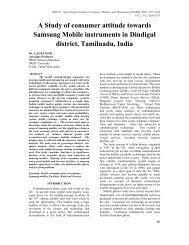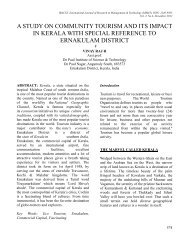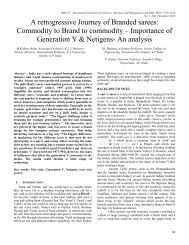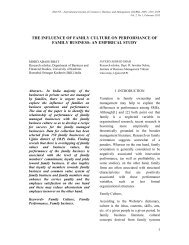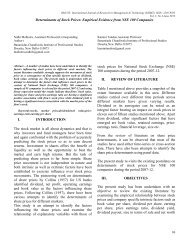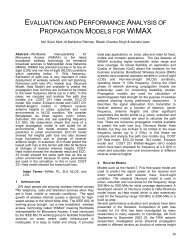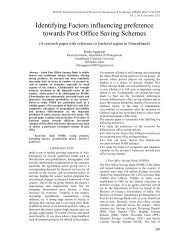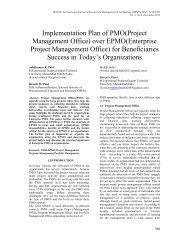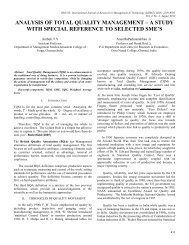Human Reliability Analysis: A review of the state of the art
Human Reliability Analysis: A review of the state of the art
Human Reliability Analysis: A review of the state of the art
Create successful ePaper yourself
Turn your PDF publications into a flip-book with our unique Google optimized e-Paper software.
should be noted that human error is a major contributor to <strong>the</strong><br />
risks and reliability <strong>of</strong> many systems: over 90% in nuclear<br />
industry [7], over 80% in chemical and petro-chemical<br />
industries [8], over 75% <strong>of</strong> marine casualties [9], and over 70%<br />
<strong>of</strong> aviation accidents [10], [11]. For this reason, st<strong>art</strong>ing from<br />
high risk industrial areas, such as nuclear, aerospace and<br />
petrochemical, up to individual SMEs, <strong>the</strong>re was <strong>the</strong> need to<br />
common techniques <strong>of</strong> risk analysis with human factor<br />
evaluation methodologies, collected under <strong>the</strong> name <strong>of</strong> <strong>Human</strong><br />
<strong>Reliability</strong> <strong>Analysis</strong> (HRA).<br />
<strong>Human</strong> <strong>Reliability</strong> <strong>Analysis</strong> identifies errors and<br />
weaknesses in a system by examining methods <strong>of</strong> work<br />
including those who work in <strong>the</strong> system. HRA falls within <strong>the</strong><br />
field <strong>of</strong> human factors and has been defined as <strong>the</strong> application<br />
<strong>of</strong> relevant information about human characteristics and<br />
behavior to <strong>the</strong> design <strong>of</strong> objects, facilities and environments<br />
that people use [12]. HRA techniques may be used<br />
retrospectively, in incidents analysis, or more likely<br />
prospectively to examine a system. Most approaches are firmly<br />
grounded in a systemic approach which sees <strong>the</strong> human<br />
contribution in context <strong>of</strong> wider technical and organizational<br />
context [13]. The purpose is to examine task, process, system<br />
or organizational structure for where weakness may lie or<br />
create a vulnerability to errors, not to find fault or apportion<br />
blame. Any system in which human error can arise, can be<br />
analyzed with HRA, which in practice, means almost any<br />
process in which humans are involved [14].<br />
III. HRA METHODOLOGIES<br />
Over <strong>the</strong> years several methodologies for <strong>Human</strong><br />
<strong>Reliability</strong> <strong>Analysis</strong> have been made. This development has led<br />
researchers to analyze accurately information in order to<br />
understand what could be <strong>the</strong> best approach for HRA.<br />
Information refers to costs, ease <strong>of</strong> application, ease <strong>of</strong><br />
analysis, availability <strong>of</strong> data, reliability, and face validity [15].<br />
Developed methodologies can be distinguished into two<br />
macro-categories: First and Second generation methods.<br />
First generation methods include 35-40 methods for human<br />
reliability, many <strong>of</strong> which are variations on a single method.<br />
Theoretical basis which relates most <strong>of</strong> first-generation<br />
methods are: error classification method according to <strong>the</strong><br />
concept “omission-commission”; definition <strong>of</strong> “performance<br />
shaping factors” (PFS); cognitive model: skill-based, rulebased,<br />
knowledge-based.<br />
The most accredited <strong>the</strong>ory to define and classify wrong<br />
action is <strong>the</strong> error classification method according to <strong>the</strong><br />
concept “omission-commission” [16]. This concept contains<br />
<strong>the</strong> following meanings: Omission: identifies an action that is<br />
not done, is done late, or is done in advance; Commission: is<br />
<strong>the</strong> implementation <strong>of</strong> a performance by <strong>the</strong> operator that is not<br />
required by <strong>the</strong> process.<br />
St<strong>art</strong>ing from <strong>the</strong>se <strong>the</strong>ories, have been developed cognitive<br />
models <strong>of</strong> second generation; <strong>the</strong> most representative<br />
techniques are: OAT (Operator Action Tree); THERP<br />
(Technique for <strong>Human</strong> Error Rate Prediction); TESEO<br />
(Empirical technique to estimate operator’s error); HCR<br />
(<strong>Human</strong> Cognitive <strong>Reliability</strong> model).<br />
IRACST- International Journal <strong>of</strong> Research in Management & Technology (IJRMT), ISSN: 2249-9563<br />
Vol. 2, No. 1, 2012<br />
Second generation methods, term coined by Doughty [17]<br />
try to overcome limitations <strong>of</strong> traditional methods, in<br />
p<strong>art</strong>icular:<br />
- provide guidance on possible and probable decision<br />
paths followed by operator, using mental processes models<br />
provided by cognitive psychology;<br />
- extend errors description beyond usual binary<br />
classification (omission-commission), recognizing importance<br />
<strong>of</strong> so-called "cognitive errors";<br />
- consider dynamic aspects <strong>of</strong> human-machine<br />
interaction and can be used as basis for simulators development<br />
<strong>of</strong> operator performance.<br />
In order to estimate and analyze cognitive reliability, is<br />
required a suitable model <strong>of</strong> human information processing.<br />
The most popular cognitive models are based on <strong>the</strong> following<br />
<strong>the</strong>ories:<br />
- S.O.R. Paradigm (Stimulus-Organism-Response):<br />
argues that response is a function <strong>of</strong> stimulus and organism,<br />
thus a stimulus acts on organism which in turn generates a<br />
response;<br />
- Man as a mechanism <strong>of</strong> information processing:<br />
according to this vision, mental processes are strictly specified<br />
procedures and mental <strong>state</strong>s are defined by causal relations<br />
with o<strong>the</strong>r sensory inputs and mental <strong>state</strong>s. It is a recent <strong>the</strong>ory<br />
that sees man as an information processing system (IPS);<br />
- Cognitive Viewpoint: in this <strong>the</strong>ory, cognition [18] is<br />
seen as active ra<strong>the</strong>r than reactive; in addition, cognitive<br />
activity is defined in a cyclical mode ra<strong>the</strong>r than sequential<br />
mode.<br />
St<strong>art</strong>ing from <strong>the</strong>se <strong>the</strong>ories, have been developed cognitive<br />
models <strong>of</strong> second generation; <strong>the</strong> most representative<br />
techniques are: ATHEANA (A Technique for <strong>Human</strong> Error<br />
ANAlysis); CREAM (Cognitive <strong>Reliability</strong> and Error <strong>Analysis</strong><br />
Method).<br />
A. First generation methodologies<br />
These tools were <strong>the</strong> first to be developed to help risk<br />
evaluators predict and quantify <strong>the</strong> likelihood <strong>of</strong> human<br />
error.First generation approaches tend to be atomistic in nature;<br />
<strong>the</strong>y encourage <strong>the</strong> evaluator to break a task into component<br />
p<strong>art</strong>s and <strong>the</strong>n consider <strong>the</strong> potential impact <strong>of</strong> modifying<br />
factors such as time pressure, equipment design and stress.<br />
First generation methods focus on <strong>the</strong> skill and rule base level<br />
<strong>of</strong> human action and are <strong>of</strong>ten criticised for failing to consider<br />
such things as <strong>the</strong> impact <strong>of</strong> context, organisational factors and<br />
errors <strong>of</strong> commission. Despite <strong>the</strong>se criticisms <strong>the</strong>y are useful<br />
and many are in regular use for quantitative risk assessments.<br />
OAT (Operator Action Tree)<br />
Operator Action Tree (OAT) was developed by John<br />
Wreathall in early 1980s. The OAT approach to HRA is based<br />
on <strong>the</strong> premise that <strong>the</strong> response to an event can be described as<br />
consisting <strong>of</strong> three stages [19]: observing or noting <strong>the</strong> event;<br />
diagnosing or thinking about it; responding to it.<br />
36



